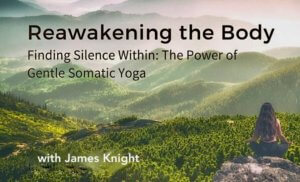What is Gentle Somatic Yoga®?
Yoga+Somatics+Energetic Therapeutic Practices
Gentle Somatic Yoga® incorporates therapeutic somatic movements that are designed to help you feel more comfortable in your body.
For many people this easily accessible method is ideal for letting go of persistent stress-based patterns of pain, stiffness, and postural imbalances.
Through a process of brain-to-muscle repatterning most people find beneficial results that are immediate and long lasting.
Gentle Somatic Yoga® is unparalleled in terms of its capacity to nourish, liberate and enhance the vitality of the Soma (Whole Self).
Gentle Somatic Yoga® incorporates therapeutic somatic movements that are designed to help you feel more comfortable in your body.
For many people this easily accessible method is ideal for letting go of persistent stress-based patterns of pain, stiffness, and postural imbalances.
Through a process of brain-to-muscle repatterning most people find beneficial results that are immediate and long lasting.
Gentle Somatic Yoga® is unparalleled in terms of its capacity to nourish, liberate and enhance the vitality of the Soma (Whole Self).
Gentle Somatic Yoga Does Not focus On Stretching
Instead of stretching muscles, Gentle Somatic Yoga (GSY) uses a technique called pandiculation to reprogram muscles to their optimal resting length.
This is just one of many practical and simple techniques James Knight, E-RYT, CHSE, has synthesized from his 30+ years of clinical practice and teaching yoga. He has helped thousands of students and clients with unwinding from pain, stiffness, and postural imbalances. As James describes it “from this place of new-found freedom, we naturally return to our natural state of peace and well-being.”
This progressive method of movement incorporates Hanna Somatic Education, hatha yoga, meditation, Core Energetics (body-oriented psychotherapy), as well as principles ascribed to quantum mechanics. James’ creation has been inspired from the work of Eleanor Criswell Hanna, Thomas Hanna, Moshe Feldenkrais, Lawrence Gold, John Pierrakos, Siegmar Gerken, Toni Petrinovich, as well as others.
GSY is dedicated to researching, pioneering, and facilitating the most leading-edge neuroscience in movement education. You can learn more through GSY’s Training Programs (Certification option), Livestream and in-person events, Somatic Wellness and Adventure Retreats, and one-on-one virtual sessions.
Gentle Somatic Yoga has been shown to be effective in reducing and/or eliminating symptoms from these conditions and more:
| · Chronic Lower Back Pain | · Poor Posture | · Sciatica |
| · Stiff Neck & Shoulders | · Muscle Spasms | · Arthritis |
| · Headaches & Migraines | · Knee Injuries | · TMJ |
| · Parkinson’s Disease | · Multiple Sclerosis | · Fibromyalgia |
| · Scoliosis | · Joint Pain | · Hip Pain |
| · PTSD | · Hamstring Tightness | . And many more… |
GSY has helped diminish, correct, and/or eliminate symptoms from these conditions:
Chronic Lower Back Pain
Poor Posture· Sciatica
Stiff Neck & Shoulders
Muscle Spasms
Arthritis
Headaches & Migraines
Knee Injuries
TMJ
Parkinson’s Disease
Multiple Sclerosis
Fibromyalgia
Scoliosis
Joint Pain
Hip Pain
PTSD
Hamstring Tightness
And many more…
What else makes Gentle Somatic Yoga unique?
Gentle Somatic Yoga is the More than the Sum of Its Parts
Hanna Somatic Education
– Hanna Somatics, developed by Thomas Hanna, provides the neuroscience of GSY. It is a gentle, sensible, and safe approach used by many certified professionals to help clients recover from chronic pain and develop ease of movement. Somatics is based on the understanding how the sensory-motor cortex is involved with the brain-to-muscle repatterning.
Hatha Yoga
– Hatha Yoga typically involves a set of physical postures (yoga poses) and breathing techniques. James adapts these hatha sequences and incorporates them with neuroscience of Hanna Somatics. Hatha yoga is also a path toward creating balance and uniting opposites that James uses to help the body develop both strength and flexibility.
Vipassana Meditation
– Vipassana provides the main meditation technique used in GSY. It is a process of observing internal felt sensation(s). This form of meditation focuses on creating a deep interconnection between the mind and body, and inspires the journey of self-exploration.
Quantum Physics
– Quantum Physics provides some of the explanation for the changes one might experience during a GSY practice. In recent years, quantum physicists have been starting to explore how meditation can change brain structures including the re-wiring of the synapses (electrochemical pathways transmitting neurons / nerve cells).
Core Energetics – See separate section on this page, down below
WHAT ARE THE DIFFERENCES BETWEEN GSY AND OTHER POPULAR STYLES OF YOGA?
is cal, In traditional hatha yoga, asanas (postures) are often practiced with the intent to reach a “full expression” of any given pose. As well, some modern day yoga classes can be experienced as an athletic workout because of the cardio, strength, alignment and flexibility that is achievable through the poses.
In some cases, especially in an environment of competition and/or comparison, performing traditional yoga poses can lead to sacrificing a more intuitive and intentional relationship with the body. There is a saying in the west: “no pain, no gain”, and with this attitude it may lead to injury through overuse and overstretching.
Gentle Somatic Yoga offers a different approach. Instead of focusing on exercise and outcome, practitioners are encouraged to discover and explore “body shapes” that are nourishing and revitalizing in the now moment. Not every soma (body) is the same, so the emphasis is on finding your own inner teacher and relying less on “doing it right” according to instruction or demonstration.
In addition, the restorative and therapeutic Somatic Movements Flows® practiced in GSY are designed to provide the soma (body) with brain-to-muscle reeducation, so that neural pathways are strengthened and/or new ones generated to release deep stress holding patterns. If there was a slogan in GSY in contrast to “no pain, no gain”, it would be “no brain, no gain”. Strength, significant flexibility, coordination, and an embodied sense of peace are natural results of GSY.
Somatic Movement Flows® target specific muscle groups by breaking down larger movements mindfully into small parts and pieces. Other tips include moving slow and smooth, pausing often to sense and feel, and the Flows end in Soma Scans which invite the body to release all muscular effort.
GSY’s main technique is called Pandiculation. This involves mindfully contracting specific muscle groups, and then slowly releasing them until they return back to their optimal length in a resting position. It is through this practice that the brain is given new information so that it can come out of Sensory Motor Amnesia (loss of voluntary muscular control) and allow more space for an integrated mind/body experience.
Gentle Somatic Yoga’s success in therapeutic settings has less to do with poses/exercises than it does with the observation of internal felt sensation and brain-to-muscle repatterning. To put it simply, the more you gain control of your muscles, the more choices you have in your body. The more choices you have, the freer you are to enjoy your body AND life to its fullest!

What is Sensory Motor Amnesia?
 Sensory Motor Amnesia (SMA) is often the root cause of chronic muscular pain.
Sensory Motor Amnesia (SMA) is often the root cause of chronic muscular pain.
What happens physiologically is that the Sensory Motor Cortex, with its main function to communicate with our muscles and help with our ability to move, switches from manual to “cruise control”. This means that with our best intentions to mentally relax our muscles, even after a massage, chiropractic, or acupuncture treatment, there is a subconscious reflex that causes the muscle groups to contract again.
The causes of SMA include:
- Repetitive daily movements: the way we sit at our desk to work, walk, pick up our children, play sports, etc…
- Physical injury: the body’s natural instinct is to contract and protect itself from pain. Think of whiplash and how the muscles of the neck stay contracted after an accident.
- Emotional stress and trauma: memory of these events are stored in our tissues.
Sensory Motor Amnesia can be self-corrected through the regular practice of Gentle Somatic Yoga.
HOW TO REVERSE SENSORY MOTOR AMNESIA?
Gentle Somatic Yoga’s slow, focused, therapeutic and restorative sequences known as Somatic Movement Flows® (SMFs) direct parts of the brain strengthen the brain-to-muscle connection so that you can be free of pain, flexible, strong, and coordinated.
Each SMF is carefully designed to provide examples of safer, more intuitive ways to move. Through conscious movements (motor), paired with internal self-sensing (sensory), your soma (body) will be invited to release old patterns of holding stress and tension stored deep within your tissues.
With regular Gentle Somatic Yoga® practice, you will most likely notice significant changes in your discomfort levels, and also the ability to move more freely as the positive effects are cumulative.
Over time, as you continue to feel stronger and flexible, you become more confident of maintaining vibrant health. As well, no matter what you are facing in your life, you’ll have clearer choice points to return back to an embodied sense of peace and wellbeing. Freedom is our natural birthright.
Article & Video Interview with James Knight By Yoga-U
 Video Interview LINK
Video Interview LINK
Article LINK
Article Excerpt:
Gentle Somatic Yoga is a process of discovery and exploration where a person can reconnect with parts of themselves that they may have disowned unconsciously through patterns of holding stress and tension from modern day life. Via a careful and methodical process using therapeutic yoga & somatic movements, the practitioner discovers for themselves from the inside out how the joints and bones stack.
“Like it or not, our bodies are a map to our whole entire life experience mentally, emotionally, physically,” James Knight states. “We temporarily forget how to use our bodies because the muscles can become unconsciously contracted even in resting states due to a reflection of stress.”
More about Core Energetics
What is Core Energetics?
Core Energetics is a method of body-oriented psychotherapy that can be thought of as a bridge that integrates the body, emotions and spirituality. Developed by John Pierakkos (Founder of Core Energetics), and influenced by Eva Pierakkos (The Pathwork), Siegmar Gerken, Alexander Lowen (Bioenergetics), and Wilhelm Reich, it is a holistic process capable of activating greater consciousness within a person.
Core Energetics allows us to compassionately examine how our reactions and defensive behaviors can lead to mental, emotional, and physical pain. During times in which we feel we need to protect ourselves, our body expresses and stores these experiences as stress, contraction, resistance to life, and feelings of isolation and separation.
Some of the techniques in Core Energetics are utilized in GSY and help clients/students accept all aspects of themselves, no matter what they are facing in their lives. Through this process, clients/students increase their capacity to navigate changes and challenges that come up, naturally. As James Knight puts it, “by trusting and responding to our body messages, we learn to make decisions that will best nurture and sustain us. Through this conscious relationship, we increase our life force (prana) and maintain a more fulfilling life. This internal process can lead to a greater spiritual awakening.”
Key values from Core Energetics James integrates into GSY
- Awareness of your authentic and Whole Self (True Self)
- Self-Acceptance and self-compassion
- Intimate and fulfilling relationship with others
- An empowering and passionate life
- Grounding techniques
- Discernment for living in harmony with your own values
- Skills to recapture your innocence
- Healthier choices in your fifestyle
- Increased feelings of pleasure and joy
- A greater ability to respond to life situations from the heart
